We’ve owned a few cars in our day
Over the years, we’ve owned all kinds of cars—from rusty old VW Beetles to brand-new sedans, a couple pickup trucks, and even a temperamental MGB convertible. Most of the time, we owned two vehicles, since we were both working – usually going in different directions every day. As our kids grew up and started driving, we sometimes added a third car for their use.
There was a lot of variety in our driveway over the years, but they all had one trait in common: They ran on gasoline.
Things were different when we moved to Portugal. For 3½ years, we lived car-free, relying on public transportation. It was affordable, reliable, and saved us the headaches of fuel, insurance, and parking—especially in Porto, where double-parking caused daily frustration for our neighbors (and that provided some entertainment for us).
Another home, another car
When we moved back to the U.S.last fall, we knew we’d have to buy a car again. We wanted something small, simple, and sustainable. So, after plenty of research, we bought an electric car—knowing full well it might be a challenge in our rural area.
Before buying the car, I did my homework—reading up on EVs, downloading charging apps, and scouting local stations around Lewiston and Clarkston. Unlike gas cars, which benefit from a century of infrastructure, charging options in rural areas are limited – and will continue to be that way, since the current president has suspended a $5 billion dollar program to build out EV charging infrastructure.
So we knew there might be some inconvenience. For a few minutes we thought about buying a hybrid. In hindsight, that might have been a smarter choice. But we convinced ourselves that going all-in on the electric car was the right thing to do, so we did it.
A different way to buy a car
I’ve never enjoyed car shopping, so I turned to Carvana, the online retailer. Our son-in-law had a good experience with them, so we decided to give it a shot. On their site I found a number of low-mileage, late model EVs. We settled on a 2022 Hyundai Kona EV with a $2,000 tax credit already applied. The purchase process was smooth—like buying something on Amazon—but delivery wasn’t so easy. They wouldn’t bring it to Lewiston; I had to pick it up in Boise, 300 miles away.
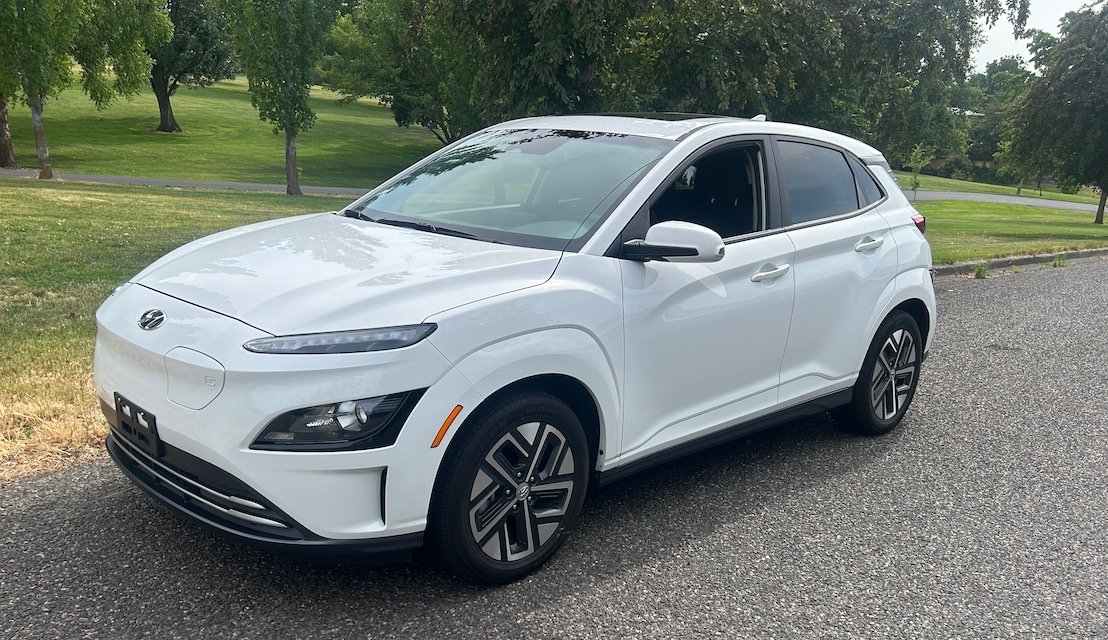
My son and I made a road trip of it, passing through some wild, remote country in eastern Oregon. For the first couple of hours there were no towns, no cell service, just trees and winding roads.
When we arrived in Boise and were walking into our hotel, I got a text from Carvana. There was a problem with the car and it wouldn’t be ready for another week. A customer service agent on their 800-line couldn’t tell me what was wrong, so I stewed overnight.
The next morning, I visited the Carvana location in person. The staff were sympathetic. They explained that the car’s horn didn’t work and that they could not legally release it to me. Further, the replacement horn wouldn’t arrive for several days.
So we agreed on a new delivery date, and this time they offered to meet me halfway so I wouldn’t have to make the long drive again.
Early days
When we first got the car, we were living in an Airbnb and didn’t have a way to charge at home. Luckily, there were several public chargers down at the Port of Clarkston. A couple of them were free to use, but very slow. So we’d plug in the car, go for a nice hour-long walk along the river, and come back with enough charge to get us through a few more days.
We had some things to learn about charging the car. For starters, there are three types of chargers in general use in the US:
- Level 1: This is essentially a trickle charger. Our car came with a Level 1 charging cord that plugs into a regular 110 volt outlet. We’ve used it a few times, and carry it with us in case of emergencies. But it would take about 18 hours to fully charge the car with one of these. Some public chargers are Level 1. The ones around where we live are generally free to use.
- Level 2: These are faster chargers that run on 220 volt AC current – like our oven or clothes dryer. These are the fastest chargers available for installation in private homes. We had a Level 2 charger installed in our garage. It will charge the car fully in 6 to 8 hours.
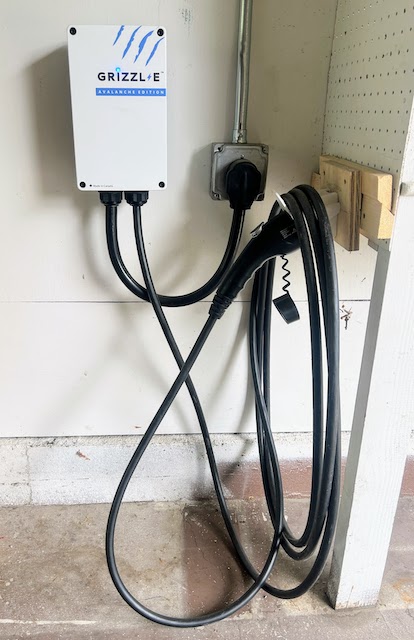
- Level 3: These are high-speed chargers that operate on 480 volt DC current. They are big boxes, usually with two charging cords. They’re mostly found in public places and usually require payment to use. They can fully charge an EV in less than 2 hours. (Your mileage may vary.)
There are also different plugs on the charger cords, which means some public charging stations are incompatible. Teslas, for instance, use a different plug than most other car brands, so most Tesla charging stations won’t work for us. (Not that we want to give Elon any more money!) Some of the larger Tesla stations – called “Superchargers” will offer one or two chargers with adapters.
Our car, when fully charged, has a range of about 270 miles. That’s more than earlier EVs, and less than newer models. A common fear about EV’s that many people have is known as “range anxiety” – the worry that your vehicle’s battery doesn’t have enough charge to get you where you want to go
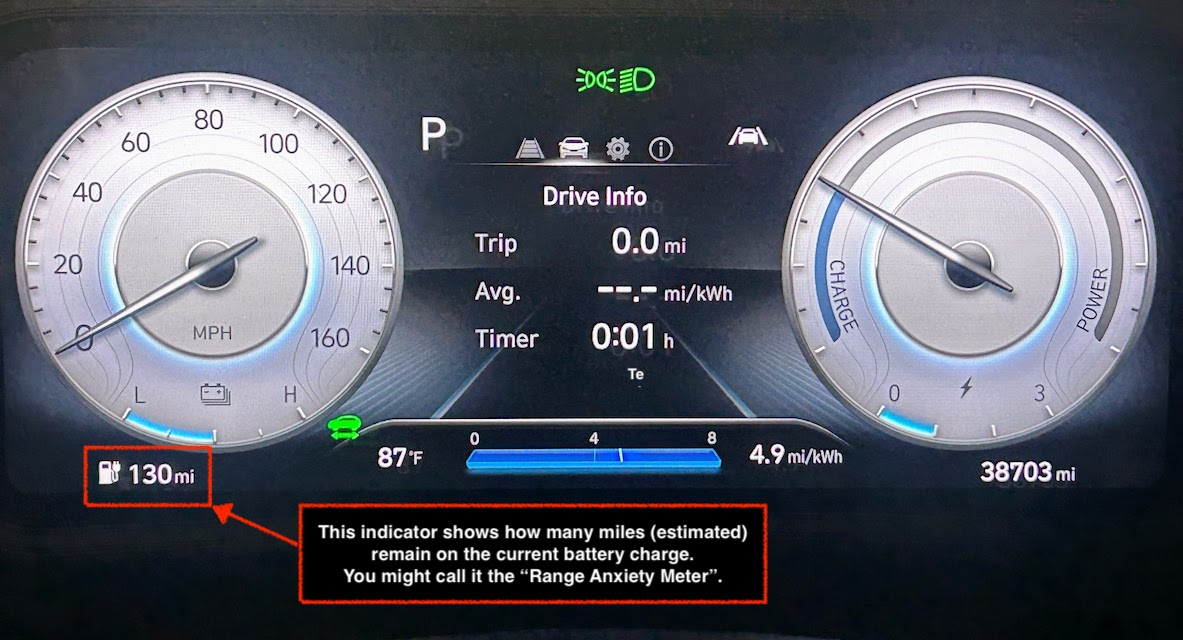
We can attest that it’s a real thing!
Shivering through the winter
Winter introduced two new wrinkles. First, cold weather reduces the capacity (and thus the range) of the batteries that power the car. Second, running the heater or defroster further drains the battery.
Whenever we turned on the heat, the estimated range indicator would drop by about 40 miles (Luckily, it would bounce back up when we turned off the heat after a few minutes.) So we learned to bundle up in the car and go without heat on short trips. This strategy worked well for a run to the grocery store or the home supply outlet, but was less pleasant on longer drives. We got used to shivering. Sort of.
Our first road trip
Our first real trip out of the area was in February. We had to be out of our house while our floors were being refinished, so we planned a weeklong trip to Spokane, Washington and Coeur d’Alene, Idaho.
The drive to Spokane was only 100 miles, but it was a cold, damp morning and the trip ate up over half of our full charge. We knew we couldn’t make it home without topping up (range anxiety again). In a residential neighborhood a couple miles from our AirBnB, we found a fast charger. It cost us about $12 for an hour of charging while we had breakfast in a nearby cafe.
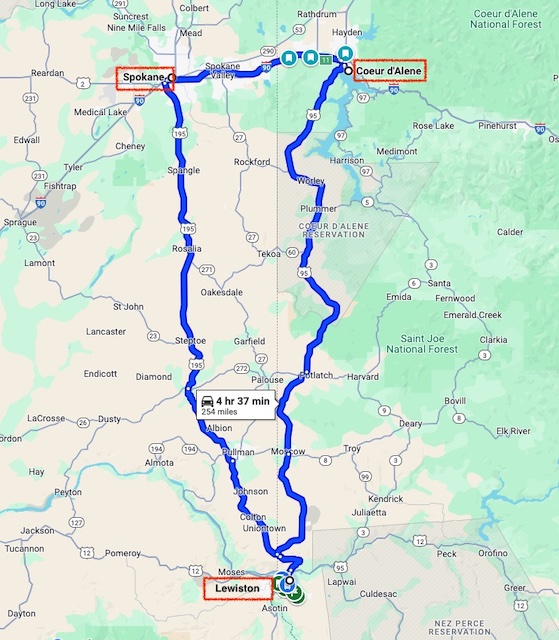
A few days later in Coeur d’Alene, we hit a snag. We needed more juice to get back and went to four different fast charging stations, but none of them worked! Back at the hotel, I plugged our trickle charger into an outlet at the back of the building and let it charge overnight. I told the clerk at the front desk, “Call me if there’s a problem.” No one called. Eighteen hours later, we had enough charge to get home.
I estimated that we spent an entire day of our trip trying to locate charging stations. Even with multiple apps to guide us, we still had difficulty.
Enjoying the spring
As the weather warmed, we got busy working on the house and didn’t make any extended trips. With just running around town, windows down, not needing heat or air conditioning, we were able to go almost a full month between charges.
Our next big trip – Leavenworth
Leavenworth is a popular resort town in central Washington. It is on our list to visit before next winter, but at 250 miles away it’s too far to reach on a single charge. During our route planning, we found a Tesla charge point about two-thirds of the way there that has an adapter for other vehicles. That will give us the boost we need to go the last 60 miles or so. (And we’ll reluctantly pay Musk about 50 cents per kw/h for the power.) We’ll have to find another charge point for the return trip.
Traveling this way definitely requires a leap of faith. If a fast charger is offline or incompatible, we’re at risk until we find a slower charging station.. There’s not much room for error and plenty of opportunities for trip delays.
So what have we learned?
For everyday use, driving around town, the car is fantastic. It’s comfortable, nimble, and holds a surprising amount of stuff. It’s like having a zippy little electric golf cart with doors and heat (well, sometimes). It’s quick off the line, too. Step on the accelerator too hard and it’ll snap you back into your seat.
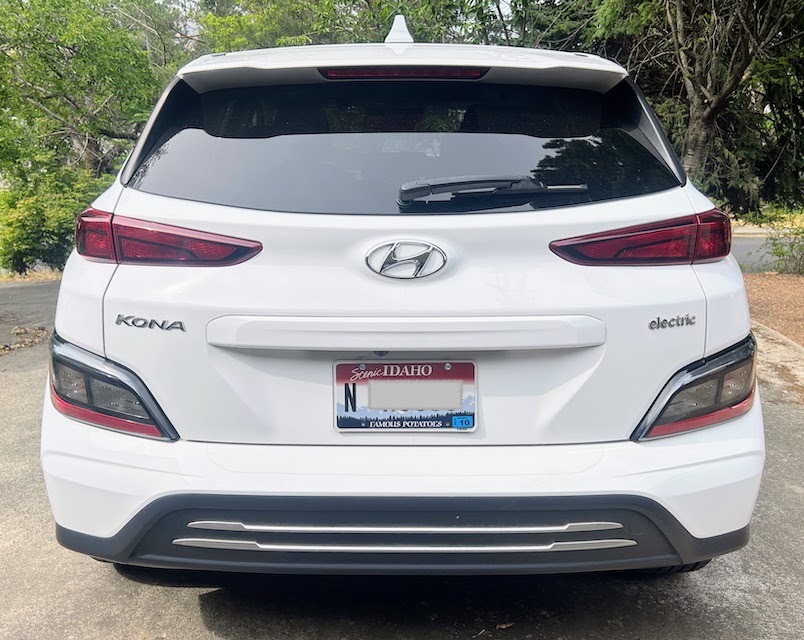
We have gone as much as a full month between charges. And when we do charge it at home, it costs almost nothing. This area has some of the lowest electricity rates in the nation – we pay just 9 cents per kilowatt hour. (I’ll do the math to tally the cost another day. For now, just know it’s cheap!)
But for long-distance travel—especially in rural areas—it’s a different story. You need a spirit of adventure and a flexible schedule in case you get stuck and have to trickle charge.
The bottom line: This is a great car for us. We think they are a no-brainer for two car families, where one is predominantly an in-town car. Hopefully the charging infrastructure will continue to improve, making it easier to go long distances.
The only thing we haven’t done yet, is give it a name.
Until next time,
Mary and Mike
The Cook and The Writer

Mary has suggested we name the car “Sparky”. Do you have an idea? Leave your suggestions in the comments below or via the Contact Us form.
P.S. – While you’re here, be sure to check out The Rabbit Hole. There’s no telling what new nonsense Mike has posted there.

We’ve had a Kia EV6 for the past two years and love it.
It’s so nippy and has plenty of range, although we’re on a small island so it’s easy to get from one side to the other on a full tank (battery!)
Hi Steve,
Thanks for joining the conversation. “Nippy” is a great way to describe the acceleration in these cars. Put your foot down and it will snap your neck!
Sorry for the delay in responding. I somehow lost several weeks. Getting caught up now.
Mike
Mike, thank you for the comprehensive information you shared after using your electric car. My experience is limited to a few days with a rental car. While I must admit that the performance is impressive, the issues of battery charging and limited driving range have convinced me that I will continue to use gasoline-powered cars with 6- or 8-cylinder engines!
Hi Livio,
Somehow, I expected that would be your response. Maybe you’ll consider a hybrid someday? 😉
Mike
We have a Niro EV. We used only the trickle charger for two years, which would take over 60 hours to fully charge. We made it work, barely. We finally got a level two charger last month and it’s glorious.
For traveling here are a couple app recommendations.
Electrify America. Level 3 charging. I like how they tell you how many chargers are available and in operation.
EV go
EV connect
ChargePoint
These are three other fast charging companies with level 3.
Lastly, there is an app called PlugShare that is crowdsourced to tell you all the different kinds of chargers available. We like to filter out all the car dealerships that are listed on there. It’s not our favorite thing to do to visit a car dealership for any reason, but if you got a charge, you got a charge.
Hey Jon,
Thanks for the suggestions. I think I have all those apps on my phone. We’re waiting on Hyundai to update the ownership record on our car so we can apply for the free Tesla adapter they’re giving to all owners. While I don’t really want to give Elon any money, I’ll do it if it keeps us moving.
And sorry to be so long replying. I somehow spaced on the last few comments.
Mike
May I suggest calling it Branco? A name to remind you of Portugal. ☺️
Anyway, thanks for detailing your EV experience. Super helpful! We are buying one in the next month or so.
Cheers!
What a great suggestion! I think that one might stick. Thanks for the comment and let us know your experience when you get an EV.
Mike
As we’ve come to know M and M as early adopters, always up for an adventure. Our next car will likely be electric, but there will always be a F150, gas, within reach.
😎
Hey Sam,
I wouldn’t recognize you without the F150 nearby.
Sam
Thanks for sharing about your EV experience! Exactly what I was expecting especially trying to do a longer distance trip. It is nice to charge at home and stay away from a gas station and not add funding for Elon when possible 😃. I bought a car from Carvana but luckily they delivered to the house since we are outside Nashville. I thought it was a great way to buy a car and not have that all day dealership experience. Thanks Mike !
Hi Monica,
Thanks for joining the conversation. We have found that several major companies don’t deliver to our little town. Not sure why. When we pass a gas station now, we always ask each other, “What are those folks doing over there?”
Have a great week!
Mike
Hi Mike. I’ve had a Mustang Mach E for a little over a year. I really like it, and have experienced the same cold weather issues with reduced range. It is not our only car though, so we only use for short trips around town, and to Indy, where our son lives. My 91 year old father has two E vehicles. A car and a truck. He really likes (and needs) the safety features they provide.
Hi Craig,
Thanks for your comment. Our realtor here has a Mustang Mach E. It’s a cool car. I remember your dad. He whizzed past me during the Mill Race Half Marathon a few years ago. I got passed by a great-grandma, too. Enjoy your weekend!
Mike